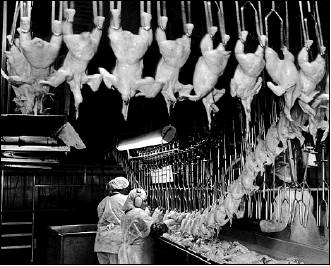Labor of love for workers’ ‘poet laureate’
Albany
Earl Dotter understands as well as anyone the hazards faced by workers who perform the five most dangerous jobs in America: logging, commercial fishing, airline piloting, roofing and trash hauling. He has stood alongside loggers wielding chain saws and felling massive Douglas fir trees in Washington state forests. In winter, he has straddled the heaving, icy deck of a large commercial stern trawler in the storm-tossed North Atlantic off the coast of Maine. He’s also been given extraordinary access with his camera behind the scenes on airport tarmacs, on commercial roofing projects and shadowing trash collectors in city neighborhoods.
As an occupational photojournalist, Dotter, 75, of Washington, D.C., has spent the past 50 years documenting American workers at work.
He has spent countless hours making images of those who labor at the most dangerous jobs — which account for the majority of the 14 American workers killed on the job each day — as well as those professions often overlooked: coal miners, farm workers, health care employees and emergency workers.
With an empathetic eye and keen photographic skills, Dotter has been called the “American worker’s poet laureate” and his gritty and moving images have been compared to the iconic documentary photographic work of Dorothea Lange, Lewis Hine and W. Eugene Smith.
Dotter is bringing to Albany his expansive award-winning photography exhibit, “Life’s Work: A 50-Year Photographic Chronicle of Working in the USA.” The free exhibit will be on display in the concourse level of the Legislative Office Building from April 22-26. Copies of Dotter’s 240-page photography book, “Life’s Work,” will be available for $69.
“It’s an exhibit worth showing on its artistic merits, and we also hope it raises awareness about the dignity of work, but also the potential hazards of work,” said Matt London, director of the NorthEast New York Coalition for Occupational Safety and Health, or NENYCOSH, which is sponsoring the exhibit. The not-for-profit organization founded five years ago is one of about 20 similar organizations around the country that conduct worker safety and health training, advocate for safer working conditions, and lobby for tougher workplace regulations and increased funding for government regulatory agencies.
Currently, the federal Occupational Safety and Health Administration, or OSHA, has roughly 2,100 inspectors responsible for the health and safety of 130 million workers employed at 8 million work sites. OSHA’s budget has remained stagnant at $552 million for the past three years. A total of 5,147 workers were killed on the job across America in 2017, the most recent year statistics are available, according to OSHA.
“We fill a void because many of these entry-level employees in nonunion jobs receive virtually no health and safety training and some of them encounter dangerous conditions,” London said. “We provide the training that a lot of low-wage workers, young workers and immigrant workers do not receive.”
In addition, between 60,000 and 75,000 deaths in the U.S. each year are directly attributed to workplace-related cancers, heart disease, respiratory disease and other ailments, London said. Organizations like his are working to reduce injuries and death in a variety of industries.
Dotter’s photography exhibit has played a role in raising awareness by touring through several states in the past year. It will travel to Boston and Buffalo after the Albany stop. Dotter is a do-it-yourself exhibitor. He and his wife, Deborah Stern, pack the 150 framed images – some as large as 22-by-28 inches – into their Dodge Caravan and drive to each city. It takes the couple up to eight hours to set up the exhibit.
Dotter has been drawn to chronicling the hard lives and struggles of American workers since he picked up his first camera, a Pentax H3v, as a student in 1968 at the School of Visual Arts in New York City.
“A camera and 50-millimeter lens forced me to connect in a very personal way with my subjects,” Dotter said. “It became a kind of therapy and a way for a very shy kid to engage with others, make a connection with the people I was photographing and communicate an idea or a theme.”
He originally aimed at a career in advertising, but changed direction after being assigned to assist coal miners and their families in East Tennessee as a worker with Volunteers in Service to America, or VISTA, the domestic version of the Peace Corps. In the early 1970s, Dotter became a photographer for the United Mine Workers Journal and he used his images to advocate for legislation to improve mining safety conditions and to address chronic health problems faced by miners, including black lung disease, caused by long-term exposure to coal dust.
“I always looked for the common ground I shared with my subjects,” said Dotter, who was raised in a working-class family in Philadelphia. He paid his tuition at San Jose State University by working in the Gallo Glass Company factory, which manufactured wine bottles. “I always approach workers with dignity and respect because I appreciate the value of the work they do.”
Dotter has seen progress over the past 50 years and his photographic documentation has helped raise awareness about workplace dangers. Together with OSHA and state regulators and a renewed focus on safety by unions and employers, worker deaths in America dropped from 38 worker deaths daily in 1970 to 14 a day in 2017. Worker injuries are down, too, from 10.9 incidents per 100 workers in 1972 to 2.8 per 100 in 2017, according to OSHA.
Dotter will bring his Canon 5D camera to Albany. London’s organization will assign the photographer to document newly arrived immigrant workers and young workers of color throughout the Capital Region. “A lot of really important work remains invisible. We hope Earl’s photography will capture the value of what these workers do,” London said.
• Paul Grondahl is the director of the New York State Writers Institute at the University at Albany and a former Times Union reporter. He can be reached at grondahlpaul@gmail. com


